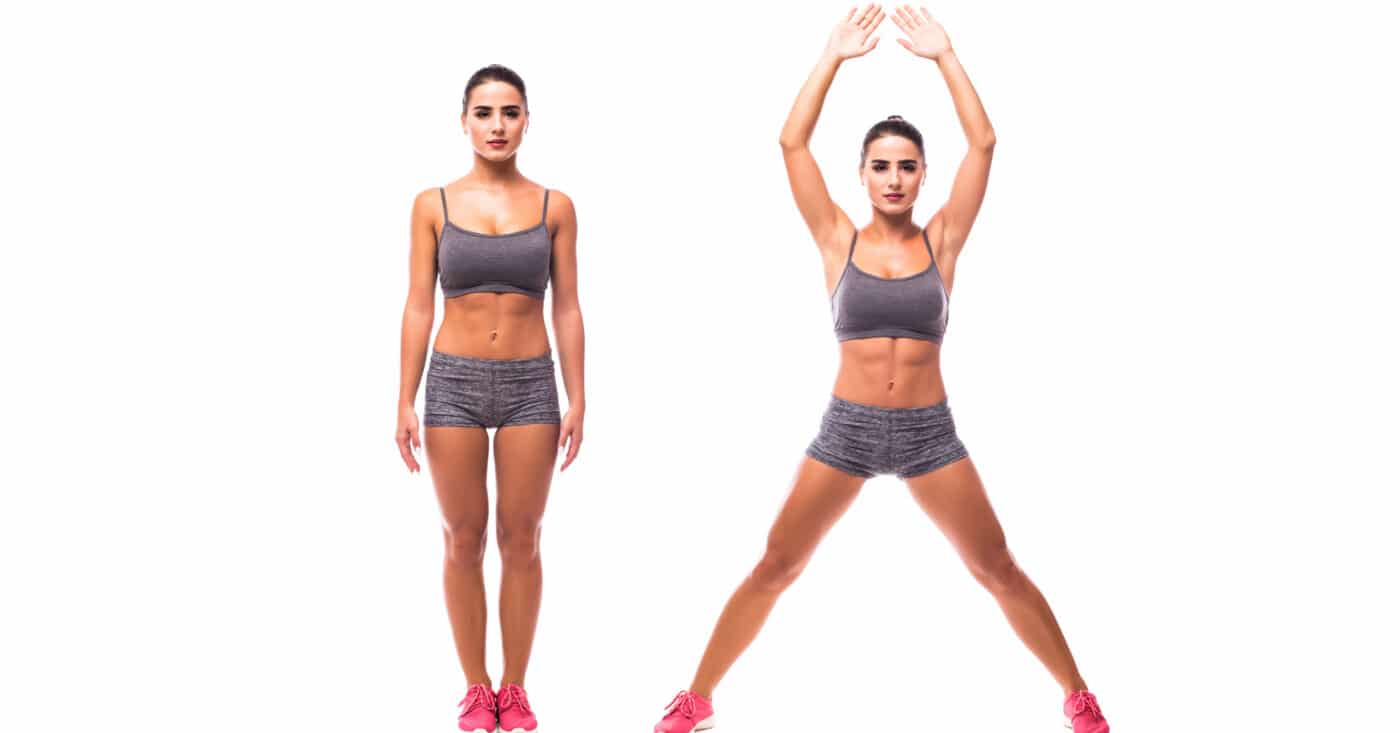If there's one exercise that everyone remembers from PE lessons, it's almost certainly the good old Jumping jack. Back then, we all probably wondered what on earth the "jumping jacks" were supposed to do. Today we know that it is a very effective fitness exercise.
This is proven not least by a number of high intensity interval training workouts. However, jumping jacks are called jumping jacks there. Although this doesn't change the exercise, it somehow sounds "cooler" and more fitness-oriented. We'll tell you why your sports instructor was on the right track back then and why jumping jacks still belong in your workout today.
Train these muscle groups with jumping jacks
The jumping jack is not only one of the best known, but also one of the most effective self-weight exercises for the whole body. The combination of jumping movements and lateral guidance of the arms trains several large muscles and muscle groups at the same time. These include the thighs, calves, buttocks, upper arms, shoulders and neck. In addition, the abdominal muscles and the muscles of the lower back are also challenged, as they have to stabilize the torso during training.
Jumping jacks not only strengthen your muscles, but also improve your coordination skills and inter-muscular coordination due to the complexity of the movement. The latter means that your muscles learn to work together more effectively and efficiently. Similar to jogging, the jumping movements exert great forces on your legs when you support your body weight. This activates the connective tissue, particularly in the knees and thighs, which relieves tension and can prevent injuries.
How many calories can I burn with Jumping Jacks?
There is no clear answer to this question, as calorie consumption depends on a number of factors. In addition to your training condition and duration, these factors also include your body weight. The longer you train and the more weight you have to move with each jumping jack, the higher the energy consumption. However, the fact that your cardiovascular system is already running at full speed after just a few repetitions and you work up a good sweat shows that your energy consumption is quite high.
This is because most of your skeletal muscles are involved in movement in some way and need to be supplied with energy accordingly. As a rough guide, you can remember that one jumping jack costs you between one and two calories. For every 100 jumping jacks, that's a whopping 100 to 200 calories. And since 100 jumping jacks can be done quite quickly, there are probably few exercises that burn more calories in less time.
How to do the jumping jack correctly
The great thing about jumping jacks is that you can do the exercise anytime, anywhere. After all, you don't need any equipment. All you need is a little space and a pair of sneakers. However, for the exercise to have the desired effect, you must of course perform it correctly. So, how do you do jumping jacks correctly?
- 1 - Get into the starting position by standing with your feet hip-width apart. Place your arms at the sides of your body and make sure that your palms are facing inwards.
- 2 - Now jump up from your calves and knees and spread your legs apart.
- 3 - At the same time, pull your arms up so that your hands are touching above your head.
- 4 - Land in a controlled manner with your legs apart and cushion yourself. From this position, jump back to the starting position.
- 5 - At the same time, return your arms to the starting position.
When performing the exercise, make sure that your posture is always straight. Even if you get tired, you should maintain optimum posture to prevent injuries. It's better to stop in good time before your technique suffers too much. It is also important that your knees remain in the correct position. Both bow legs and knock-knees are taboo.
Other Jumping Jack variants
In addition to the classic jumping jack, there are a few other variants or variations of the exercise that have a slightly different movement sequence or are simply more intense. The best known of these is the planck jack. Here you start the jumping jack in the plank position, i.e. in the forearm support. Instead of jumping up, you push your legs off the floor and spread them apart into a V-position and then return to the starting position. Plank jacks work the abdominal muscles particularly hard.
Alternatively, you can also perform the jumping jack star. Start with your thighs slightly bent in the starting position of the classic jumping jack. Now jump forcefully off the ground and spread your arms and legs out to the side in a star shape. Land with your legs and arms apart and then jump back to the starting position.
How to integrate Jumping Jacks optimally into your training
As a stand-alone workout, jumping jacks are naturally not very attractive. That's why it's important that you incorporate the exercise into your training program in the best possible way. So, when did your sports instructor use jumping jacks in the past? That's right, during the warm-up. And this is exactly where jumping jacks really come into their own. By activating a large part of the skeletal muscles, your circulation really ramps up and is ready for greater exertion during training.
The muscles themselves as well as tendons, joints and ligaments are also warmed up quickly in this way. Caution: When doing jumping jacks to warm up, you should start slowly and not perform the movements abruptly. After all, your body is still cold, which increases the risk of injury.
The "jumping jack" interval training
Another exciting option is to integrate it into interval training, such as a HIIT workout. Here, the jumping jack can live up to its reputation as an absolute calorie killer. Combine the jumping jack with other exercises such as the mountain climber or burpees, for example, and perform them for 60 seconds at a time without a break.
Active regeneration with jumping jacks
One last option is the cool-down. Admittedly, with a strenuous exercise like jumping jacks, nobody really thinks about a relaxed cool-down. However, the aim of this variant of active regeneration is to stimulate blood circulation throughout the body once again. The increased blood flow has two effects.
Firstly, metabolic end products from training are transported out of the muscles more quickly. Secondly, the body can begin to break down damaged tissue more quickly and initiate the repair phase. Together with a proper post-workout shake or a timely and protein-rich meal, the effect is greatest.
Shape @Home Bundle
Stay fit at home! The Shape @Home Bundle consists of 4 high-quality & very effective products. The name says it all. Get in Shape and that in your own four walls! The all-round package, which focuses on fat reduction, weight reduction and butt and tummy tightening and from home!
Shape @Home Bundle



